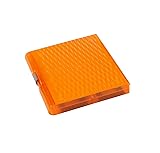All Categories


Wheaton 900400 Staining Dish Complete, with Glass Lid, Stainless Steel Rack (Case Of 6)
Share Tweet
Get it between 2025-01-21 to 2025-01-28. Additional 3 business days for provincial shipping.
*Price and Stocks may change without prior notice
*Packaging of actual item may differ from photo shown
- Electrical items MAY be 110 volts.
- 7 Day Return Policy
- All products are genuine and original








Wheaton 900400 Staining Dish Complete, with Glass Features
-
Stainless steel rack holds 50 slides
-
Rack handle made from non-tarnishable stainless steel that is resistant to staining solutions
-
Dish and slide rack manufactured from soda-lime glass that resists staining from Eosin or Hematoxylin
About Wheaton 900400 Staining Dish Complete, With Glass
This slotted rack holds 50 microscope slides, sizes 3” x 1” (75mm x 25 mm), 3” x 1-1/2” (75mm x 38 mm), and 3” x 2” (75mm x 51 mm). The rack is made of non-tarnishable stainless steel that is resistant to staining solutions. The handle is permanently attached, but hinged to permit closure of the dish and easy insertion and removal of the microscope slides. The dish is manufactured from soda-lime glass. Approximate inside dimensions: 185mm L x 88mm W x 68mm D. Wheaton offers a variety of staining dishes and Coplin jars suitable for various histology staining. Routine staining is performed to give contrast to the tissue being examined, as without staining it is very difficult to see differences in cell morphology. Hematoxylin and eosin (abbreviated H&E) are the most commonly used stains in histology and histopathology. Hematoxylin colors nuclei blue, eosin colors the cytoplasm pink. To see the tissue under a microscope, the sections are stained with one or more pigments. There are hundreds of various techniques which have been used to selectively stain cells and cellular components. Other compounds used to color tissue sections include Safranin, Oil Red O, Congo red, Fast Green FCF, Silver salts and numerous natural and artificial dyes that were usually originated from the development dyes for the textile industry.






















